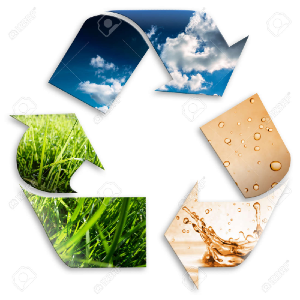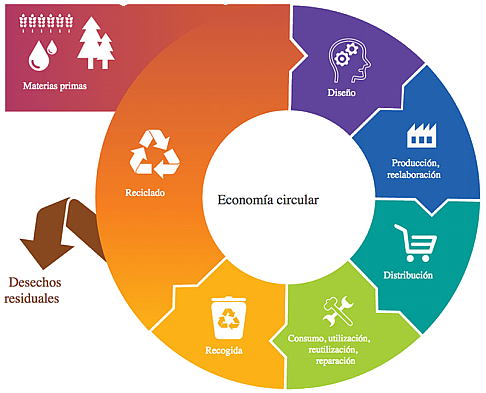Circular Economy
The current economic system is based on a growth model that relies on the production of goods and services on a “use-consume-throw away” basis
This linear model leads to intensive use of natural resources and creates a high pressure on the environment that is behind the most serious manifestations of the environmental crisis we are experiencing, including climate change and biodiversity loss.
The linear model entails aggravated impacts on resources and ecosystems, high volumes of waste, greenhouse gases that accentuate climate change, contamination of soils and water bodies, etc.
The Circular Economy offers an answer, even before production, within the framework of a sustainable design, which allows for the minimisation of the resources generated, but encourages the surplus resulting from production to be reincorporated into production as a raw (or secondary) material. In response to this situation, the Spanish Circular Economy Strategy, Spain Circular 2030, has been drawn up.

Spain Circular 2030 lays the foundations for promoting a new model of production and consumption in which the value of products, materials and resources is maintained in the economy for as long as possible, in which the generation of waste is minimised and those that cannot be avoided are used to the greatest possible extent. The Strategy thus contributes to Spain’s efforts to achieve a sustainable, decarbonised, resource-efficient and competitive economy.
The Strategy also ties in with recent major international initiatives to safeguard a healthy environment: the Paris Agreement on climate change, the 2030 Agenda for Sustainable Development and the United Nations Environment Assembly Ministerial Declaration “Towards a pollution-free planet”, agreed in December 2017 in Nairobi.
Lines of action
LOGISTOP will analyse the different players involved in achieving a more circular industry in the different sectors and how to transform them to achieve the objectives set at national and European level through collaborative projects between the different agents involved in each of the chains.
The current guidelines are indicative, but will soon be mandatory for all sectors and stages of the different value chains.
- Sustainable production chains
- Sustainable products (value chain of products and processes).
- Sustainable mobility – environmental greening of freight transport.

Link to the Sustainable Development Goals – SDGs
Goal 8, objective 8.4
Improve global resource efficiency in consumption and production, and strive to decouple economic growth from environmental degradation in line with the different agendas on sustainable consumption and production with developed countries taking the lead.
Goal 11
Make cities and human settlements inclusive, safe, resilient and sustainable.
Goal 12
Ensure sustainable production and consumption patterns.
Goal 13
T ake urgent action to combat climate change and its impacts

Thematic areas
The circular economy is an economic concept that is interconnected with sustainability and aims to keep the value of products, materials and resources (water, energy, etc.) in the economy for as long as possible, while minimising the generation of waste.
It is a concept that goes beyond the good basics and habits of recycling, reusing and recovering any surplus element, taking into account the production process and also the stage prior to production or later in the warehouse, logistics or distribution.
The principles on which the Circular Economy is based are as follows:
Preserving and improving
natural capital; that is, controlling stocks and balancing flows of renewable resources.
Optimising resource
efficiency by circulating products, components and materials in use to their maximum utility at all times in both technical and biological cycles.
Promoting
system efficiency by disclosing and discarding negative externalities as waste.
Sustainable supply chains
“Circular economy as a vector of ecological transition and driving force for change”.
What is envisaged is the individualised study of production processes, taking into account the different players involved in them, in order to achieve a more circular industry in different sectors. It is necessary to know the details of each process and the particular casuistry, in order to propose a modelling and definition of KPIs that allow a transition of the current processes towards those that contribute to circular economies. The objectives are to achieve (1) the development of more efficient processes and (2) the empowerment of the agents in the chain (including the end consumer).
The competences provided by this working group are as follows:
- Knowledge of the degree of circularity of the chains.
- Identification of opportunities for closing cycles, preventing the generation of waste and improving its final management.
- Specific knowledge in process modelling.
Advanced process modelling and optimisation techniques, based on hybrid artificial intelligence models and process optimisation tools, can be used to propose measures to transform processes to meet national, European and global targets (SDGs).
This approach is valid for different industrial sectors, all of which are players in logistics processes, such as the following:
- Electronics and ICT.
- Agri-food.
- Containers, packaging, plastics.
- Textile and clothing.
- Fishing and forestry.
- Industrial.
- Tourism.
Sustainable products (Product and process value chain)
“Eco-design as a lever for circularity”.
An environmentally respectful model based on prevention, reuse, repair and recycling is proposed. The optimisation of materials and their waste minimises the environmental cost both in the manufacturing/production phase and at the end of their life cycle. In addition to extending their useful life, it allows materials and products to be given a “second life”. To do this, products must be designed to be reused, converting waste into new raw materials.
Ecodesign considers the environmental variable as another decision-making criterion in the product design process. Within the Circular Economy model – which prioritises the use of resources and the reduction of raw materials – this approach thus becomes an alternative to the current economic model. The current production model has been depleting natural resources. In order to have a sustainable development, the product must be designed to be reused and recycled. Thanks to eco-design, from the first piece to the last can be reused or recycled once its useful life is over.
Hence the importance of Life Cycle Assessment in the Circular Economy approach. The life cycle analysis of a product, service or activity (LCA) facilitates the assessment of the environmental impact that each product, service or activity generates throughout its life cycle. That is, from the procurement of the raw material and its transport, to the production of the product, its distribution, its main use, its reuse for other purposes, its recycling or its disposal.
The Circular Economy Working Group develops new technologies and methods for sustainable urban planning and operation by providing globally positive systems in the field of agent-based modelling, optimal operation and control of complex supply networks, etc. Special attention is given to the development of holistic methodologies that assess the entire life cycle of resources and waste to enable a smooth transition to circular economies. This takes into account:
- Transport prior to production (raw materials).
- The energy and activities required to convert raw materials into the desired product.
- The delivery of the final product to the customer.
- The utilisation of the finished product throughout its useful life.
- Its recycling.
Management of its waste.
With regard to waste management techniques, work is being done with
- Definition of integrated data management systems to assess to monitor the level of circularity and sustainability of the implemented strategies.
- Design of software architectures (also in FIWARE), data mining, modelling (using both AI and knowledge models) and blockchain.
- Definition and monitoring of KPIs including environmental impact assessment (LCA) for the optimisation of systems considering circular economy criteria.
This approach is valid for different industrial sectors, such as construction (in studies of the life cycle of materials and optimised use of built spaces), water management (with improvement and reuse processes) or mobility (analysis of the costs of a vehicle in relation to its useful life and usage times).
Sustainable mobility – environmental greening of freight transport
“Efficient, sustainable and environmentally friendly distribution”.
In recent decades, cities have invested considerable effort in developing mobility strategies to ensure that urban passenger transport effectively contributes to sustainability. The development of sustainable urban mobility plans has already led to the creation of targeted infrastructures to address challenges such as environmental pollution or climate change and to ensure the sustainability of passenger transport systems. In contrast, the development of urban logistics infrastructure with similar criteria has not received the same attention. This situation has several causes: its lower media relevance, the lack of specialised technicians in the public sector with an integral vision of logistics, the great atomisation of the sector (with a multitude of operators and other agents to take into account) and the lack of data sources and analysis techniques for its monitoring.
In less than a decade the circular economy will be the only economy and will replace today’s linear economies, therefore, the entire logistics and supply chain should be transformed in the same way aiming at sustainability. These circular business models encourage the continued reuse of materials with the aim of minimising waste and the demand for additional consumption of natural resources, as indicated by the consulting firm Gartner.
Some of the effects of the digital transformation on urban logistics, such as e-commerce or vehicle sensorisation, represent an opportunity to reverse this situation. This area of the working group proposes to exploit such opportunities to offer analytical solutions to better design urban logistics networks.
Specifically, actions focused on proposing sustainable goods distribution models are envisaged, linked to the following areas:
- Decarbonisation of distribution vehicles:
- Zero-emission vehicles.
- Battery life cycle.
- Hydrogen and electric vehicles.
- Optimisation of distribution processes:
- Distribution optimisation:
- Reduction of kilometres and emissions.
- Reduction of vehicles through optimisation and load balancing between fleets. Collaborative Logistics / Horizontal Collaboration.
- Artificial Intelligence applications, enabling technologies:
- Distribution and route planning.
- Dynamic re-planning.
- Distribution optimisation:
